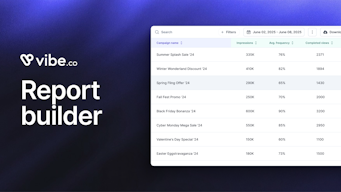CTV, OTT and Linear TV, what is the difference?
Commercial videos are no longer the monopoly of television. Today, marketers have many options on the web to advertise their products or services and increase their brand awareness: CTV, OTT… all terms that designate new forms of advertising. But what exactly do they mean, and what potential do these terms hold for your marketing strategy? We help you find your way in the maze of acronyms and start harnessing the power of online video advertising.
The launch of Netflix a decade ago revolutionized the way we consume video content. Traditional cable channels, such as HBO or Showtime, have declined in favor of new streaming video services online. Your television is no longer a simple device, it has to be “smart” or connected. We have seen the emergence of new actors, so-called "over-the-top" providers, which deliver content directly to consumers via a single application or website. OTT services thus compete with pay-TV for viewers.
But what exactly is the difference between CTV, OTT and linear TV?
What is CTV (Connected TV)?
CTV or Connected TV is a television which can stream video content via a device connected to a television which streams from the web, or a television connected directly to the internet.
A CTV device could be a console (such as Xbox or Playstation) or a ‘stick’ which plugs into your television (like Chromecast, Roku, Fire TV, Apple TV, etc.) These devices usually include apps from OTT services in order to access video content.
They’re becoming extremely popular, as evidenced by the fact that 94% of American households with any kind of television currently have a connected device and at least 40% of adults in these households watch these at least once a day.
You may also be interested in: Top 5 questions about Connected TV answered
What is OTT (Over-the-top)?
OTT, or Over-The-Top, is different to traditional cable or satellite TV: this is the delivery of video content over the Internet, as opposed to via TV cable or antenna. OTT content can be consumed on any device such as a TV, a phone, tablet, or even a computer, without paying any subscription to a traditional cable TV. OTT content only requires an internet connection to be viewed.
When it comes to OTT, content is accessed through streaming services including Netflix, FuboTV, Hulu, Sling, Disney+ or Amazon Prime Video as well as broadcaster apps for catch-up and on demand services. Some of these services are either free and ad supported or paid with ads or without (such as Netflix).
What is Linear TV?
Linear TV is the ‘traditional’ way of accessing television content, just like your parents and maybe even their parents did (perhaps in black & white though). It refers to the way in which viewers can consume the content: they’re reliant on the broadcaster schedule. That Content is broadcasted on a particular channel at a particular time, and linear TV is accessed through a free-to-air service via an analogue or digital signal, or a cable or satellite subscription.
The benefits of OTT:
- OTT helps you increasing your audience by promoting your products and services to your potential customers anywhere and anytime: not only when they are sitting on their couch at night, but at every hour of the day and on a variety of devices : smartphones during their daily commute, laptops at work, tablets at night or in the train…
- OTT allows you to reach a more valuable audience, thanks to precise targeting options. Don’t waste any more time and money creating and broadcasting TV commercials to grannies if you are selling Nikes…
- You can measure the performance of your campaigns, better understand your target customers and thus adjust and optimize your ads to increase your conversion rate. Your get the power of traditional TV commercials combined with the power of data analytics.
The benefits of CTV:
- Like OTT, CTV helps you reaching prospects you could not reach via commercials broadcasted on traditional TV, especially millennials.
- CTV helps you target a specific audience segment, by taking advantage of a large data set.
- A CTV campaign provides you with measurable results, which you can use to optimize your costs.
TL;DR - summary of CTV, OTT and Linear TV differences.
- A connected TV (CTV) refers to the device used to stream OTT content. A connected TV “or smart TV” is a TV which has an internet connection and is therefore able to deliver its viewers video content in a streaming or video on demand (VOD) format, besides their traditional cable subscription.
- OTT is the mechanism through which the video content is delivered, in this case, over the internet. OTT content can be consumed on any device that supports web browsers and screen-friendly interfaces.
- Linear TV is content accessed through cable subscription or free-to-air signal, as opposed through the internet with OTT. This is the traditional Television as our parents and grandparents used to watch it.
Why should marketers integrate CTV and OTT advertising in their marketing mix?
You have read the article until this point and did not start building your OTT advertising campaign yet? Well, if you need more convincing, stay with us.
With the growing penetration of digital media in homes and increased screen time, leveraging multi-screen channels like OTT (Over-the-Top) and CTV (Connected Television) is the best way to provide consumers with a compelling brand message and reach the right audience in the right context. With a multi-channel OTT campaign, you ensure that the consumer gets to see your advertisement when they are most likely to act.
On average, the consumer attention span is estimated to be around eight seconds and according to ComScore, 64% of users are more likely to buy a product online after watching a video. Besides, the impact of algorithms in online advertising means users no longer just follow the most popular topics but rather what's most relevant to them, whether they choose to engage with it or not. Being able to offer your targets personalized videos according to their interests and to broadcast them at the most convenient time is therefore highly strategic for marketers.
With solutions like Vibe, your campaigns are managed in one place and you can easily track their performance. The more you advertise, the more you get a thorough understanding of your target audiences, their preferences and behavior, giving you the keys to exponentially amplify the effectiveness of your next campaigns.


